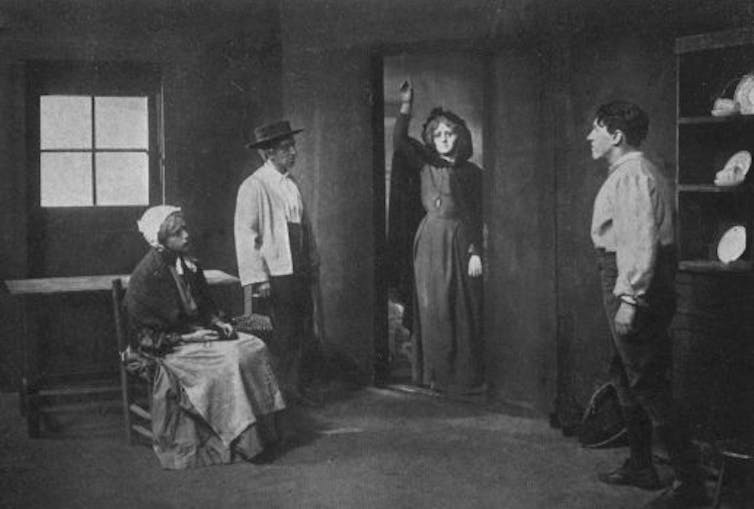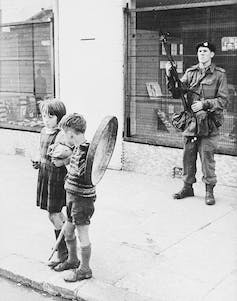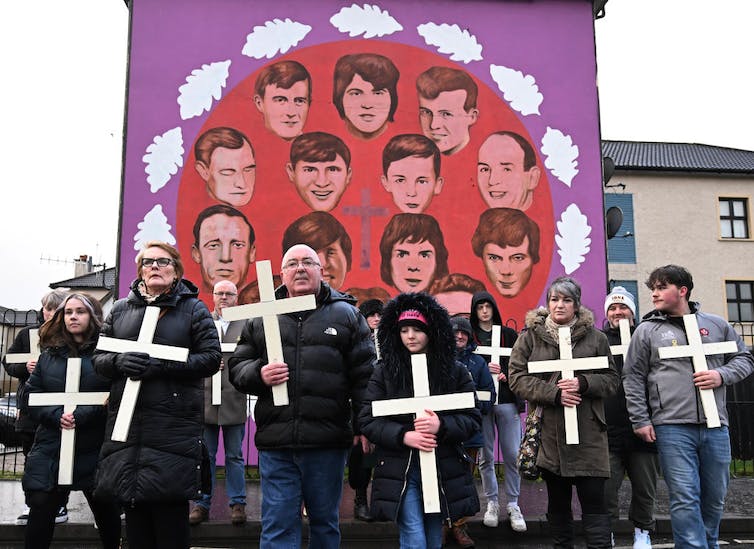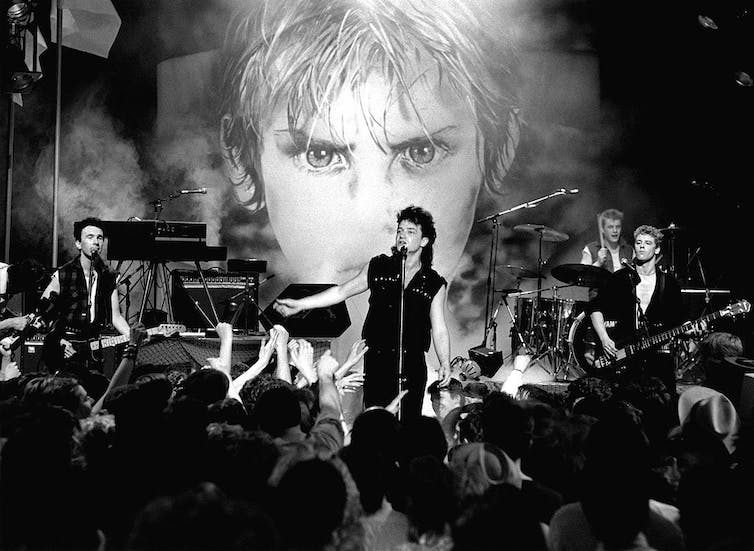A mural in Derry commemorating the TV present 'Derry Girls,' which follows the lives of youngsters rising up amid Northern Ireland's troubles. Dominic Bryan, CC BY-NC-ND
A 9-year-old boy lies on the ground of a working-class rowhouse in Belfast, Northern Ireland, wondrously watching American Westerns on TV. Outside, although, the world’s gone mad. Broken glass and shattered masonry. Barricades go up. Rifle-toting troopers patrol the streets.
It’s August 1969, the summer time that Northern Ireland’s ‘troubles’ flared into violence.
The scene is from “Belfast,” director Kenneth Branagh’s ode to rising up within the grinding battle that will go on to kill a number of thousand folks. Branagh’s Academy Award-winning movie premiered in 2021, greater than twenty years after the Good Friday Agreement introduced the troubles to an in depth on April 10, 1998 – 25 years in the past this month.
This was the second interval of so-called troubles in Ireland. The first concerned a bloody guerrilla warfare that led to 1921, with the island partitioned into an impartial, largely Catholic south and a largely Protestant north that remained a part of the United Kingdom.
But that division did little to settle the age-old warfare of cultural id. Since then, every technology of artists has used theater, tune and movie to mirror on their states’ still-uneasy peace – made all of the extra difficult by Brexit.
‘Four inexperienced fields’
For tons of of years, British tradition stereotyped the “native” Irish as savage, bestial, childlike, lazy, belligerent and, above all else, unruly: a tribe that wanted British civilization – and, subsequently, its colonization. Irish nationalists like poet W.B. Yeats, who needed to free the entire of Ireland from British rule, felt they needed to flip this script by purging the island of “Anglo” influences, reviving the Irish language and selling Celtic arts.
In 1902, Yeats wrote the masterpiece of this Celtic revival, “Cathleen ni Houlihan.” The one-act play dramatizes conventional songs and legends a few poor outdated girl pushed from her farm by strangers. Cathleen recruits a groom – on the eve of his wedding ceremony day, no much less – to assist struggle to retrieve her “4 stunning inexperienced fields.”

A scene from ‘Cathleen ni Houlihan.’
Project Gutenberg/Wikimedia Commons
It’s an apparent allegory: She is Ireland, the fields are Ireland’s 4 provinces, and the strangers are the British. The blood of Irish martyrs nourishes the outdated girl, and on the play’s finish, Cathleen transforms right into a younger lady “with the stroll of a queen.”
Cultural satisfaction helped gasoline help for Irish independence, and the Irish Republican Army drove the British out of three of the island’s 4 provinces by 1922. But a majority of individuals in a lot of the ultimate province, Ulster, recognized as British, so a brand new nationwide border was drawn to separate the 2 communities.
That gerrymandered border sparked a civil warfare within the new Irish Free State between the “die-hard” nationalists, who needed to maintain preventing the British until they deserted the north, and the “Free Staters,” who compromised to make peace. Martin McDonagh’s 2022 movie “The Banshees of Inisherin,” nominated for 9 Academy Awards, may be considered as an allegory of the Irish Civil War – the tragedy when brothers in arms flip their weapons on each other.
Spiraling disaster
Many Protestants loyal to the U.Ok. considered the tradition of Northern Ireland’s minority Catholic inhabitants as a menace and handled them as second-class residents. In the late Nineteen Sixties, partly impressed by Martin Luther King Jr.‘s civil rights activism within the U.S., Catholics started campaigning in opposition to discrimination. Their calls for had been met with violence, just like the 1972 Bloody Sunday bloodbath, through which British troopers shot and killed 14 unarmed protesters in Derry, often known as Londonderry – rival names that themselves mirror the sharp divide between communities.

A soldier on patrol in Belfast in 1969.
Bettmann/Getty Images
Tribal emotions spiraled increased, pitting largely Protestant “unionists” loyal to the U.Ok. in opposition to Catholic “nationalists” who sought reunion with the Republic of Ireland. Neighborhoods had been segregated and big partitions went as much as hold Catholic and Protestant aside, however wave after wave of reprisals got here anyway, together with bombings and sniper assaults.
As the troubles intensified, people musician Tommy Makem’s standard tune “Four Green Fields” drew once more on the legend of Ireland as a poor outdated girl:
“I’ve 4 inexperienced fields, certainly one of them’s in bondage
In strangers’ arms, that attempted to take it from me
But my sons have sons as courageous as had been their fathers
My fourth inexperienced area will bloom as soon as once more,” stated she.
It grew to become a nationalist battle name, and an indication of the occasions, as loads of younger males joined the IRA’s marketing campaign in opposition to British management of Northern Ireland.
Nowhere was the “them and us” perspective extra evident than on the gable ends of rowhouses, the place nationalists and unionists every painted murals celebrating their heroes and remembering the atrocities perpetrated by the opposite facet.

Families of the victims and supporters stroll previous a mural that includes the 14 victims of Bloody Sunday as they commemorate the fiftieth anniversary of the bloodbath, in 2022.
Charles McQuillan/Getty Images
‘Sing a brand new tune’
In the mid-Seventies, a gaggle of writers and actors, together with the Nobel laureate poet Seamus Heaney, tried to blaze a method out of this cultural loss of life spiral. Calling themselves “Ireland’s Field Day,” they tried to create artwork that could possibly be a “fifth province” of Ireland, a spot that will transcend sectarian politics.
U2 wrote its hit tune “Sunday, Bloody Sunday,” the primary tune on its 1983 album “War,” in the identical spirit. It begins with photographs harking back to the bloodbath in Derry 11 years earlier than:
Broken bottles below youngsters’s ft
Bodies strewn throughout the dead-end road
In U2’s telling, the villain just isn’t the opposite facet. The enemy is the violence itself, generated by the suggestions loop of Nationalism and unionism. The solely method out is to refuse “to heed the battle name.”
The album ends with the tune “40,” a soulful echo of the Bible’s fortieth Psalm: “I’ll sing … sing a brand new tune.”
This form of pondering helped lead the war-weary folks of Northern Ireland to the Good Friday Agreement, additionally referred to as the Belfast Agreement, in 1998. Its offers formed the power-sharing system Northern Ireland has in the present day, which legitimizes each identities. People in Northern Ireland can select to be residents of the U.Ok., residents of the Republic of Ireland, or each.

U2 performs on a tv present in 1983, with an illustration from the duvet of its ‘War’ album behind it.
Erica Echenberg/Redferns through Getty Images
It has, by and enormous, labored. Over the years, this dedication to spiritual, political and racial equality tamped down the tribalism and violence. The border between Ireland and Northern Ireland grew to become much less and fewer related. By 2018, half of the folks in Northern Ireland described themselves as “neither nationalist nor unionist.”
A brand new technology
Brexit, nevertheless, has turned the road between Ireland and Northern Ireland into the one land border between the U.Ok. and the EU. Both nationalist and unionist identities are on the uptick, and the proportion of individuals in Northern Ireland claiming neither id has plummeted to 37%.
Even so, anthropologist Dominic Bryan, co-chair of Northern Ireland’s Commission on Flags, Identity, Culture, and Tradition, is optimistic that tradition has constructed up a resistance to “us versus them” tribalism – mirrored, partly, by how folks keep in mind the troubles.
He despatched me an image of a mural in Derry, painted one yr after Brexit, which celebrates Lisa McGee’s hit TV present “Derry Girls.” Launched in 2018, the comedy follows the fictional lives of 5 youngsters rising up within the troubles. Though the present focuses on a Catholic group, it defuses the “us and them” mind-set about id. An episode referred to as “Across the Barricades” satirizes facile makes an attempt to get Catholic and Protestant youngsters to bond; it ends once they acknowledge their frequent enemy: dad and mom.
In the final episode of the primary season, whereas the children take care of the anxieties of a highschool expertise present, the tone shifts dramatically. The adults are watching a TV information report of “one of many worst atrocities of the Northern Irish battle.” A bomb has killed 12 folks and injured many extra, and “anybody with medical coaching” is urged to “come to the scene instantly.”
The viewers doesn’t know if the bomb was detonated by Catholic terrorists or Protestant terrorists. It doesn’t matter. The violence is sort of a twister or an earthquake: a catastrophe suffered by all of Derry’s residents, who choose up the items collectively.
![]()
Joseph Patrick Kelly is affiliated with the Charleston County (SC) Democratic Party.
